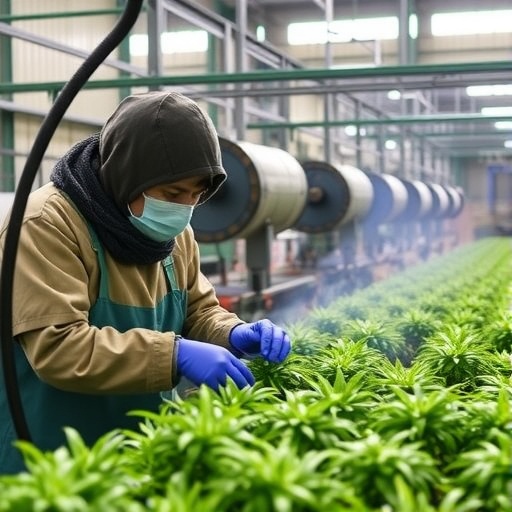In the ever-evolving landscape of global manufacturing, the emphasis on environmental sustainability has taken center stage. Recent research conducted by Bekabil, Jayamohan, and Beyene sheds light on the various factors influencing environmental innovation adoption within manufacturing firms in Shaggar City, Ethiopia. The study offers a critical analysis of how these determinants shape organizational behavior and the broader implications for sustainable development in the region.
As industries worldwide grapple with the pressing challenges of climate change and resource depletion, manufacturers in Shaggar City are no exception. This research identifies key drivers that propel firms towards adopting environmental innovations. The methodology employed by the researchers involved a comprehensive survey targeting various manufacturing entities, gathering data on their practices, perceptions, and barriers related to environmental innovations. Such empirical insights are vital, particularly in developing economies, where the balance between growth and sustainability often presents complex challenges.
One of the primary determinants highlighted in the study is the regulatory environment. The researchers found that government policies and regulations play a significant role in nudging firms towards environmentally favorable practices. Stricter environmental regulations compel manufacturers to adopt cleaner technologies to comply with the legal framework. This regulatory push is not merely punitive; it also creates a level playing field that encourages sustainable innovation, thereby fostering a more competitive marketplace.
In addition to external regulations, the study underscores the importance of internal organizational factors. Leadership commitment to sustainability emerges as a critical factor influencing environmental innovation. Firms led by visionaries who prioritize environmental stewardship tend to be more proactive in integrating sustainable practices into their operations. This leadership-driven approach creates a culture of sustainability that permeates throughout the organization, motivating employees to innovate and embrace eco-friendly initiatives.
Furthermore, the availability of financial resources is another significant determinant. The research reveals that access to finance can empower manufacturing firms to invest in innovative technologies and processes that align with environmental goals. Without sufficient financial backing, companies may struggle to implement the necessary changes required for adopting sustainable practices. Therefore, understanding the financial constraints faced by these firms is crucial for fostering the widespread adoption of environmental innovations.
Collaboration within the industry also emerges as a strong theme in the study. The findings indicate that firms that engage in collaborative efforts with stakeholders, including suppliers, customers, and research institutions, are more likely to adopt environmental innovations. This collaborative spirit not only facilitates knowledge transfer but also opens avenues for shared investments in green technologies. Such partnerships can amplify the impact of individual firm efforts, contributing to a collective movement towards sustainability within the manufacturing sector.
Moreover, the researchers highlight the role of customer preferences in shaping environmental innovation adoption. As consumers become more environmentally conscious, their purchasing decisions increasingly favor companies that demonstrate a commitment to sustainability. This shift in consumer behavior serves as a powerful motivator for businesses to innovate. In Shaggar City, where competition is intense, the ability to meet customer demands for greener products can provide firms with a distinct competitive edge.
The study further delves into the technological advancements available to manufacturing firms. The introduction and implementation of innovative technologies often depend on the perceived benefits, such as cost savings and improved productivity. Manufacturers that recognize the long-term advantages of investing in environmentally friendly technologies are more inclined to adopt such innovations. This recognition can transform the narrative around sustainability from being perceived as a cost burden to being viewed as a strategic investment.
In understanding the barriers to adoption, the research addresses the prevalent issue of resistance to change within organizations. Many manufacturers are caught in a traditional mindset where established practices are favored over innovative approaches. Overcoming this resistance requires strategic change management initiatives that emphasize the benefits of environmental innovation both for the firm and the environment at large. Addressing these psychological barriers is crucial in steering manufacturing firms towards more sustainable practices.
The influence of training and education on environmental innovation adoption also merits discussion. The analysis indicates that firms investing in employee training programs related to sustainability tend to achieve higher rates of innovation adoption. When employees are equipped with the necessary knowledge and skills, they are more likely to identify opportunities for implementing environmentally friendly practices within their roles. This highlights the need for ongoing education in fostering a culture of sustainability throughout the workforce.
While the potential for environmental innovation adoption within manufacturing firms in Shaggar City appears promising, the study also acknowledges significant challenges that lie ahead. For instance, the lack of infrastructure to support green technologies can impede progress. Additionally, macroeconomic factors, including fluctuating market conditions and political instability, may pose further hurdles. Thus, a holistic understanding of the regional context is essential in formulating effective strategies to enhance sustainability within the manufacturing sector.
In conclusion, the determinants of environmental innovation adoption among manufacturing firms in Shaggar City, as revealed in this insightful research, paint a picture of both opportunities and challenges. The interplay of regulatory frameworks, organizational practices, financial resources, collaborative efforts, consumer preferences, and education will ultimately define the path toward sustainable manufacturing in the region. As the world looks to mitigate the impacts of climate change, the findings from this study could serve as a guiding framework for policymakers and industry leaders seeking to propel environmental innovations in developing economies.
Overall, the research offers valuable lessons for countries aiming to balance economic growth with environmental preservation, showcasing that sustainability is not merely an obligation but a compelling opportunity for innovation and competitive advantage in the modern manufacturing arena.
Subject of Research: Environmental innovation adoption among manufacturing firms in Shaggar City, Ethiopia
Article Title: Determinants of environmental innovation adoption among manufacturing firms in Shaggar City, Ethiopia
Article References:
Bekabil, U.T., Jayamohan, M.K. & Beyene, A.B. Determinants of environmental innovation adoption among manufacturing firms in Shaggar City, Ethiopia.
Discov Sustain 6, 1068 (2025). https://doi.org/10.1007/s43621-025-01883-6
Image Credits: AI Generated
DOI:
Keywords: Environmental innovation, manufacturing firms, sustainability, Shaggar City, Ethiopia




